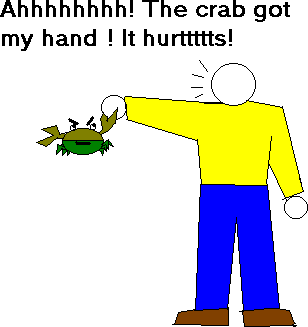Handling Crabs
Ahhhhhhhhhhhh! The crab got my hand! It hurtttttts!
This yelling and other variations of this are probably what
you will hear if someone, or you got pinched by the fierce, armored
creatures that you are all trying to catch. I, personally, have
never been pinched (prove of my expertise), and you can do that
too. Keep your crab catching trip(s) a painless one by reading
and remembering the information in following paragraphs.
Removing Crabs From Your Gear
Measuring Crabs
Picking up Crabs
If You Get Pinched...
Removing Crabs From Your Gear
 |
|
The situation we are trying to avoid
|
After you pull your trap(s) or dip
net(s) up, you will need to remove the crab(s) from the trap(s)
or dip net(s) and measure the
large ones (no point measuring the small ones that you can tell
are under legal size). You won't have any problems here if you
use star/pyramid traps, ring nets, dip nets, your own hands, or
a cage/pot that opens on the top or sides. If you have a cage
with no-exit entrances but no easy retrieval features, this gets
a little more dangerous. You will need to hold these entrances
open, lift the cage and shake the crabs out (don't stick your
hand inside the cage to grab the crabs. I hope you are smart enough
to know why). You should pay attention to your finger and where
the crabs are in the cage.
Measuring Crabs
Once you get all the crabs (and other things) out of your trap(s)
and dip net(s), you will need
to take the crabs for measuring. If you have a caliper
(you should) or a ruler, you can measure the crab right on the
floor. Gently put one foot on the carapace (note gently, don't
try to crush the crab. You will have crunched crab for dinner)
to prevent the crab from scurrying away, then measure the widest
point of the carapace. If you need to carry the crab to a measuring
bracket on the dock or pier, please read the next section.
Picking up Crabs
After you have measured the crabs and returned the undersized
ones to the water, you will need to carry your catch and put them
into a container. Warning: This is where most of injuries
sustained during crabbing will happen. The crab's formidable pincers
can cause you substantial amount of pain (I wouldn't really know
since I have never been pinched, but I can see it from the facial
expressions of the people getting pinched) and can cut your skin.
I have seen people get cut by crab pinches. You also have to watch
out for the crab's other legs. They are pointy and crabs frequently
try to stab you with them if you try to pick the crabs up.
The absolutely safest way to pick up a crab is to use a
pair of tongs. You will not have to make contact with
the crab, therefore eliminating any chance it has of pinching
you. You can also wear protective gloves. They will prevent you
from being cut, but won't protect you from the pressure of the
pinch, which can still cause considerable discomfort.
Although those are the safest ways to pick a crab up, most people who
catch crabs (including me) use just our bare hands. This is a
bravado thing. Even though this is a much riskier way, it makes
you look like an expert in front of others and can give oneself
a sense of accomplishment. In order to safely pick up the crab
with your bare hands, first you need to get behind the crab. You
can put a foot on the crab to prevent it from turning around or
scurrying away. Hold the rear part of the crab along with some
rear legs. Don't grab just the legs. The legs are in rotational
sockets and the crab can "bend" downwards and pinch
you. You need to have a good grip on the rear part of the crab's
body, so that the crab can't move its body (crabs have rigid bodies).
Carrying a crab can usually be done with one hand. Beginners need
time to practice a few times but after some practice, you will
find this very easy and natural.
 |
 |
 |
|
The safest way to carry crabs is
to use tongs
|
The powerful claw of the red rock
crab
|
This is the the usual way to hold
a crab. Grabbing some of the rear legs might be a good idea
too.
|
If You Get Pinched...
The purpose of this section is to explain to you what
you should do if a crab gets a hold of you.
If you start to feel a pinching pressure on your hand when you
pick up a crab, drop the crab immediately. You can always pick
it up later. There is no need to risk injury. In the unfortunate
event that the crab gets a grip on your hand (Ouch!), it probably
wouldn't let go without some persuasion. You can try flicking
your wrist. It might work or it could just increase the pain.
The best way is to let the crab back into the water. It will let
go if goes into the water. You can use a dip
net to retrieve the crab or put it into your water-filled
container. (I will tell you why you might want to have a water-filled
container in the Storing Crabs page.)
|
<<Back To
|
Next>> | Storing Crabs | ||

